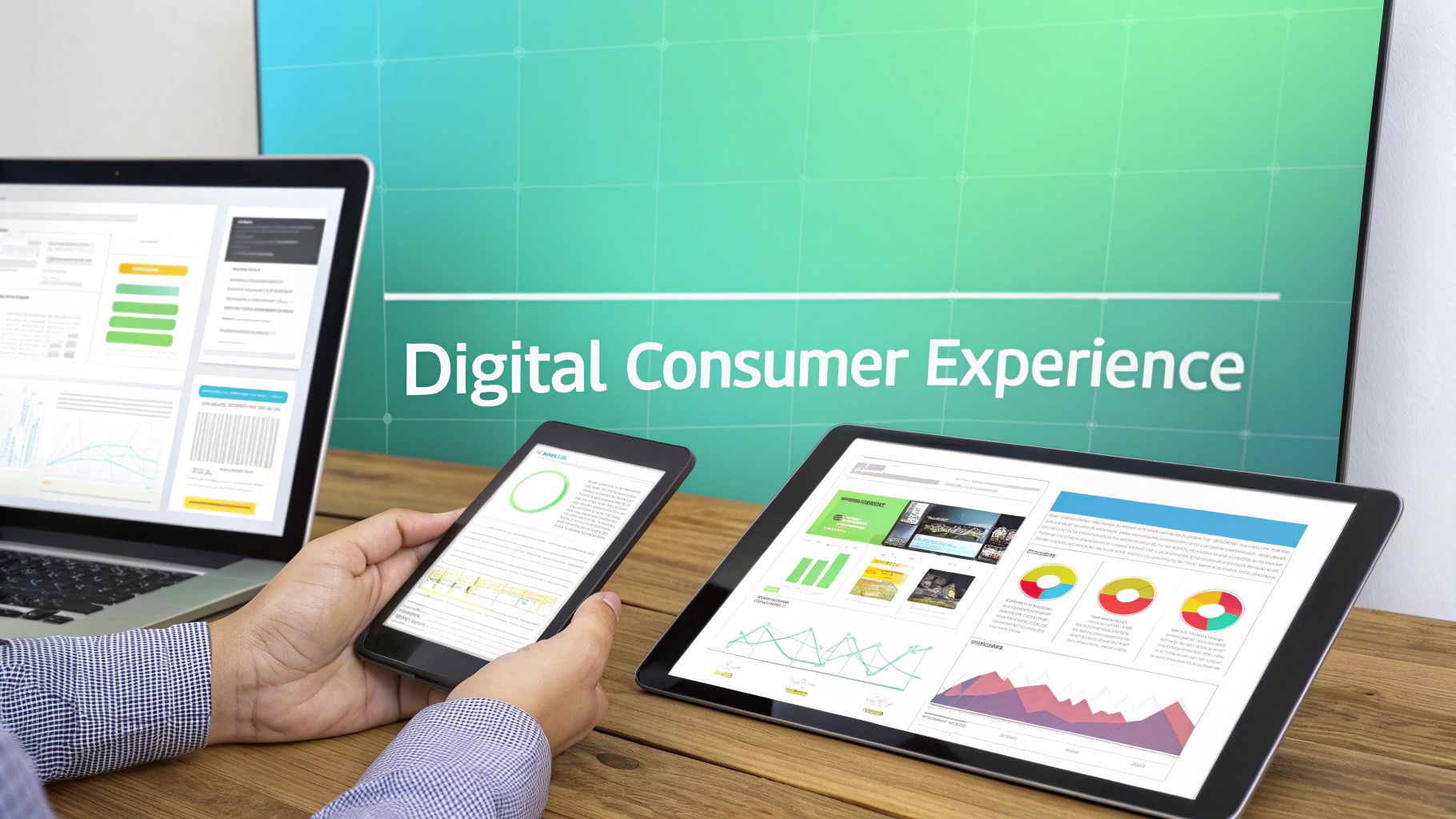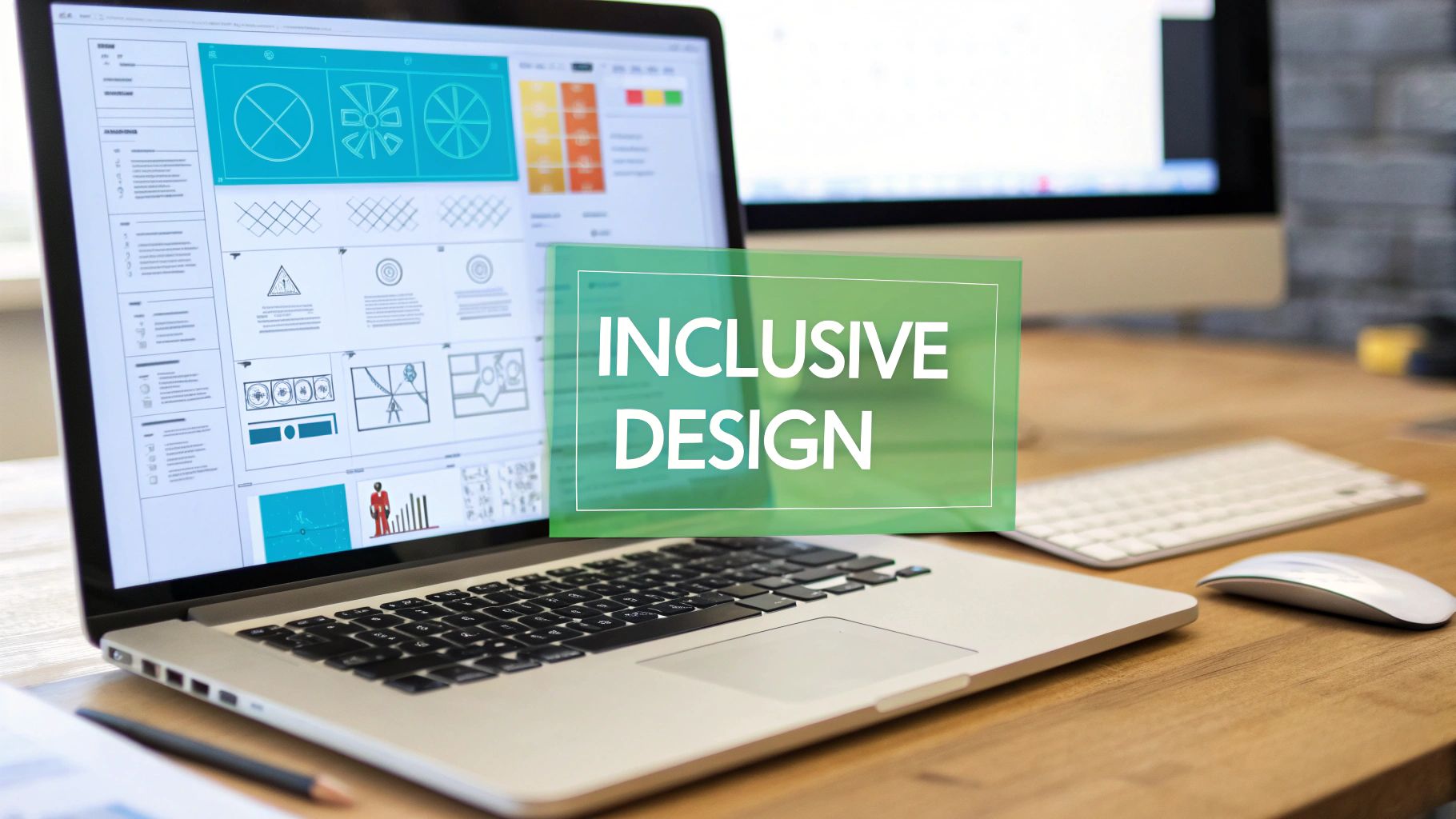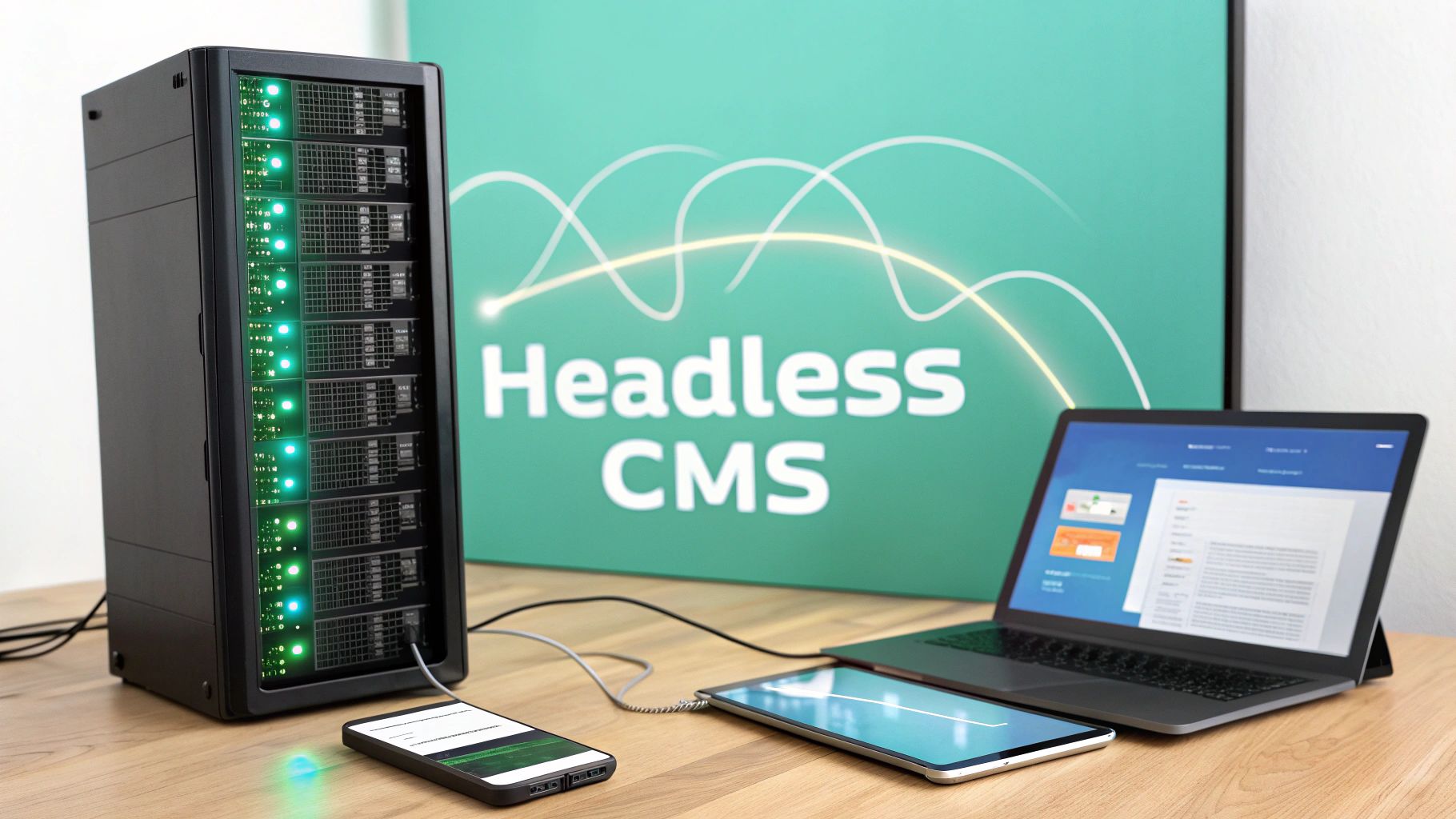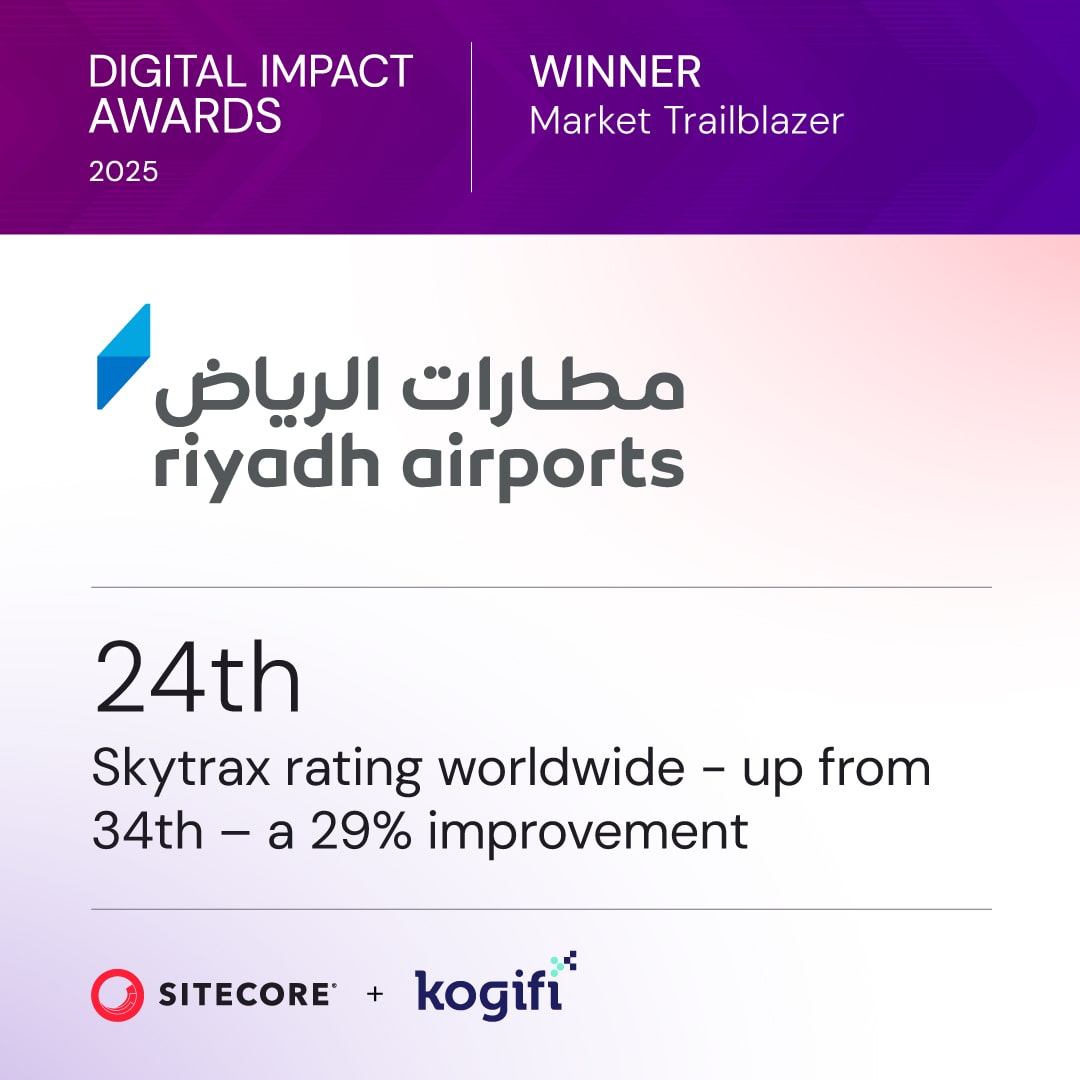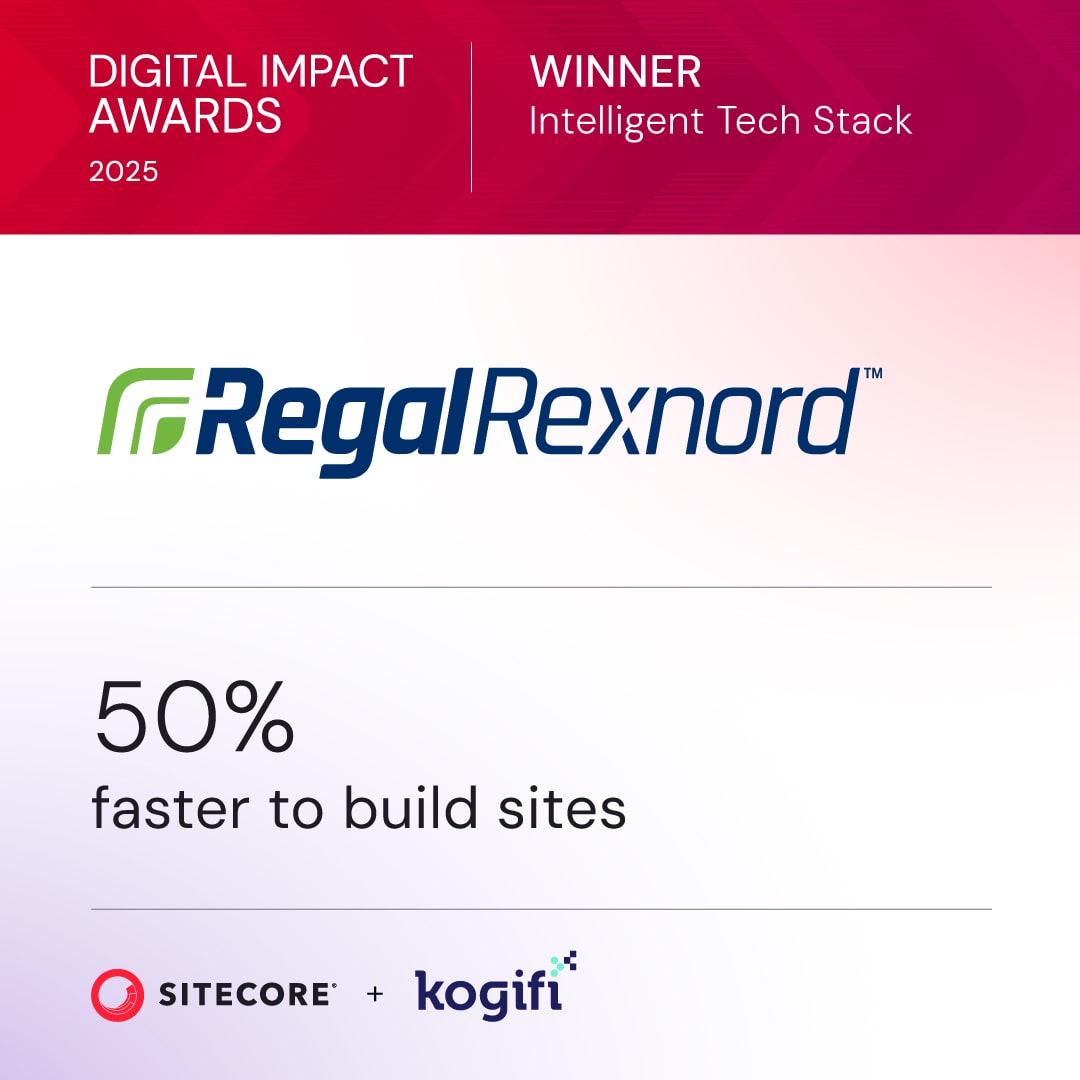The digital consumer experience is the sum of every digital interaction a customer has with your brand. It’s not just a single click on your website or a purchase through your app; it's the entire feeling and perception a person forms about your business across every digital touchpoint, from social media to chatbots.
When done right, a great experience feels seamless, intuitive, and personal.
Understanding The Modern Digital Consumer Experience

In the past, a customer's journey was a relatively straight line. Today, it’s a sprawling web of interactions that jump between multiple devices and platforms. The modern digital consumer experience is the grand total of all these digital moments, woven together into a single story.
Think of it like a personal concierge who knows you so well they can anticipate your needs. This concierge offers tailored suggestions whether you're browsing on your laptop at home or using a mobile app on the go—often before you even know what you're looking for. That’s the gold standard we're aiming for: making the customer feel completely understood and valued at every turn.
This seamless feeling doesn't happen by accident. It's carefully orchestrated by powerful technology designed to pull together scattered data points into one coherent view of the customer. This is where platforms like a composable Digital Experience Platform (DXP) become the engine that drives it all, managing content, personalizing interactions, and delivering a consistent message everywhere.
The Shift From Transactions To Relationships
The biggest change in the modern digital consumer experience is a move away from focusing on one-off transactions and toward building long-term relationships. People don't just buy products anymore; they buy into a brand's story and the way it makes them feel.
A clunky or frustrating digital journey shatters that connection in an instant. That’s why every single touchpoint matters—a slow-loading webpage, a confusing checkout process, or an irrelevant email can undo all the hard work you've put into building your brand. To get it right, it's critical to implement proven e-commerce user experience best practices that keep customers happy and engaged.
Balancing Personalization With Privacy
Looking ahead, the digital consumer experience is getting even more sophisticated. By 2025, it will be defined by a delicate balance between hyper-personalization and a strong demand for data privacy. Customers expect experiences tailored specifically for them, powered by smart technology, yet they also insist on having total transparency and control over their personal data.
This paradox is shaping the future of digital engagement.
A great digital experience is seamless, intuitive, and consistent. It’s about more than functionality; it's about making the customer feel known and respected throughout their entire journey with your brand.
Striking this balance requires a solid technological foundation. A well-integrated DXP, for instance, is designed to gather and act on customer data responsibly, allowing businesses to deliver personalized content without breaking user trust. If you want to learn more, you can explore a detailed explanation of what a Digital Experience Platform is in our other article.
This foundation is what transforms a series of isolated interactions into a cohesive and memorable digital consumer experience.
To better understand what goes into crafting this experience, let's break down the essential components that shape a consumer's journey and their perception of your brand.
Key Components of the Modern Digital Consumer Experience
Each of these elements plays a critical role. When they work together harmoniously, they create a digital consumer experience that not only meets expectations but exceeds them, turning casual visitors into loyal brand advocates.
Why a Great Digital Experience Drives Business Growth
In a crowded market, the quality of your digital consumer experience isn't just a feature on a checklist; it’s your most powerful competitive advantage. It’s moved well beyond simple website functionality to become the very engine of business growth. A superior digital journey translates directly into measurable financial gains, creating a clear line between customer satisfaction and bottom-line results.
Think about it. When a customer's interaction with your brand is seamless, intuitive, and personalized, it builds a deep sense of trust and loyalty. This positive feeling isn't just a warm fuzzy; it directly moves the needle on key business metrics like higher conversion rates, increased average order value, and a much stronger brand reputation.
On the flip side, a clunky or frustrating experience comes with a real cost. Every broken link, slow-loading page, or confusing checkout process is an invitation for customers to leave, often sending them straight into the arms of a competitor. These negative moments create tangible losses through cart abandonment, lower customer lifetime value, and the damaging ripple effect of negative reviews.
The Financial Impact of a Superior Experience
This is why investing in a robust Digital Experience Platform (DXP) is not an operational expense—it's a direct investment in revenue and long-term customer relationships. Platforms like Sitecore provide the tools needed to turn exceptional digital interactions into measurable business growth by unifying the entire customer journey.
For instance, Sitecore's composable architecture allows businesses to orchestrate every touchpoint with precision. By integrating a powerful Content Management System (CMS) with advanced personalization and commerce capabilities, companies can deliver hyper-relevant content at the exact moment a customer needs it. This transforms a generic browsing session into a guided, one-to-one conversation that smooths out the path to purchase.
Getting this right is more critical than ever, especially with recent data showing a concerning trend. Forrester's 2025 Global Customer Experience Index reveals a troubling worldwide decline in CX quality. In North America, a staggering 25% of brands saw their CX rankings fall for the second year in a row, with only 7% showing any improvement. This dip was seen across effectiveness, ease of use, and emotional connection, signaling a major opportunity for brands that can actually deliver. You can dig into the details in the Forrester report on the global customer experience.
Connecting Internal Processes to External Success
A truly great digital consumer experience also hinges on what’s happening behind the scenes. This is where integrating a solution like SharePoint becomes a massive strategic advantage. While Sitecore manages the customer-facing experience, SharePoint can act as the central nervous system for your internal teams.
By using SharePoint as an enterprise content management hub, you ensure that all product information, support documentation, and internal knowledge are consistent and easy to find. This internal efficiency has a direct external impact.
When your customer service, sales, and marketing teams are all pulling from a single source of truth, they can deliver a more consistent and reliable experience to the end consumer.
This integration creates a powerful feedback loop:
- Customer data from Sitecore pinpoints friction points and content gaps.
- Internal teams use SharePoint to collaborate on and update the necessary resources.
- Sitecore delivers the refined content, creating a digital experience that gets better over time.
Ultimately, a superior digital consumer experience creates a virtuous cycle. Happy customers are more likely to become repeat buyers and brand advocates, which drives organic growth. Their positive interactions generate valuable data that, when funneled through platforms like Sitecore, allows for even deeper personalization. This commitment to the experience is what separates the market leaders from everyone else, turning simple digital interactions into a sustainable and profitable business asset.
The Three Pillars Of An Exceptional Digital Experience
Delivering a standout digital consumer experience takes more than luck—it demands a thoughtful mix of strategy, data, and design. At its heart lie three interlocking pillars:
- Deep Personalization
- Omnichannel Consistency
- Seamless Design
When these work together, every interaction feels natural and purpose-built. Now let’s unpack what each pillar really means—and how you can bring them to life.
Deep Personalization Beyond The First Name
True personalization isn’t about dropping someone’s first name into an email. It’s about reading between the lines—anticipating needs and serving the right content at the moment it matters.
Imagine a shopper returning to your homepage. Rather than a generic hero banner, they’re greeted with an offer for the very product category they browsed last week. Suddenly, a one-size-fits-all homepage transforms into a private conversation.
This precision relies on a Customer Data Platform (CDP) like Sitecore CDP, which gathers signals from every touchpoint—web visits, app sessions, past orders—to build a complete, 360-degree profile. From there, tools such as Sitecore Personalize can make split-second decisions, adapting headlines, images, and calls to action on the fly. To dive deeper into these tactics, check out our guide on personalization on the web.
Personalization isn’t a gimmick—it’s a promise that you know your customer’s needs before they do.
Omnichannel Consistency Across All Touchpoints
Your customer’s path rarely stays on one device. They might spot a product on Instagram, research it on desktop, then finish the purchase in your app. Each step needs to feel like part of a single, uninterrupted story.
Omnichannel consistency means:
- Carrying the same brand voice everywhere
- Preserving shopping carts across devices
- Ensuring a chatbot hand-off seamlessly reaches a live agent
With a composable, headless CMS such as Sitecore XM Cloud, your content lives in a central repository while presentation layers adapt to web, mobile, kiosks—even IoT screens. No more silos. No more surprise blank carts.
“An omnichannel strategy doesn’t just mean being present on multiple channels; it means connecting them into a single, cohesive ecosystem where the customer is always at the center.”
Seamless Design For Effortless Interactions
The final pillar focuses on stripping out friction. Think intuitive menus, uncluttered visuals, and lightning-fast load times. After all, even the most targeted message fails if the page won’t load.
Seamless design operates on two fronts:
- Front-end polish: clear navigation, responsive layouts, minimal clicks
- Back-end efficiency: sub-second page loads, optimized assets
Internally, tools like SharePoint can serve as a central knowledge hub—keeping product specs, FAQs, and support articles accurate and organized. When your external search or chatbot taps into that hub, customers find exactly what they need.
The increasing preference for digital self-service underscores the need for frictionless design. By mastering these three pillars—deep personalization, omnichannel consistency, and seamless design—you’ll be ready to meet the demands of the modern consumer head on.
Weaving Your DXP with Sitecore and SharePoint
Building a powerful Digital Experience Platform (DXP) is all about choosing the right building blocks and making them work together.
Let’s walk through a practical setup centered on Sitecore’s composable suite: XM Cloud, CDP, Personalize, and OrderCloud.
We'll also see how bringing SharePoint into the mix creates a single source of truth for your internal teams, making everyone’s job easier.
Sitecore Composable DXP Components
Think of Sitecore XM Cloud as the heart of your content operations. It's a headless CMS, which means it separates your content from how it's displayed. This API-first approach lets you push consistent, on-brand content to any channel you can imagine—websites, mobile apps, IoT devices, you name it.
The real beauty of this decoupled model? It dramatically cuts down the time it takes to get new experiences live and fuels a dynamic digital consumer experience.
To understand how each piece fits, it helps to see them side-by-side.
Sitecore's Composable DXP Portfolio at a Glance
Each Sitecore product plays a specific, vital role in creating a unified and deeply personal digital consumer experience. This table breaks down what each one does and why it matters.
As you can see, this isn't just a random collection of tools. They're designed to work in concert, turning anonymous visitors into loyal customers through tailored interactions and frictionless journeys.
The Role of Each Sitecore Module
So, how does it all work in practice? It starts with data. Sitecore CDP is the brain, gathering data from every single touchpoint to build a rich, unified profile for each customer.
This profile then feeds Sitecore Personalize with real-time behavioral insights, allowing it to make smart decisions about what content or offer to show next. Here’s a typical flow:
- Data Ingestion: The CDP pulls in data from your website, mobile app, and even offline sources to create that 360° customer view.
- AI Decisioning: Personalize uses AI to instantly select the perfect content block based on the customer's profile and current behavior.
- Content Delivery: XM Cloud pushes that tailored content to the user’s screen in milliseconds.
- Commerce Execution: If a purchase is involved, OrderCloud handles everything from product listings and pricing to a smooth checkout process.
This seamless sequence is what creates a digital consumer experience that feels incredibly intuitive and aware of the user's context.
Gaining Agility with XM Cloud
Because XM Cloud’s architecture is decoupled, your content editors can publish updates across multiple channels without waiting on developers. This is a game-changer.
Teams can test new page layouts in days instead of weeks, often reducing launch cycles by over 40%.
- Parallel Workflows: Developers and editors can work at the same time without stepping on each other's toes.
- Channel Flexibility: The API-first design means your content is ready for the web, mobile apps, kiosks, and whatever comes next.
- Version Control: Content branching allows you to safely experiment with new ideas and roll back if needed.
- Localization: Headless APIs make it incredibly fast to deliver translated content to global markets.
This kind of agility makes your digital consumer experience incredibly responsive, letting you adapt to market shifts on the fly.
Extending Commerce with OrderCloud
OrderCloud isn't your average e-commerce engine. It’s a composable, API-first platform built to handle complex B2B and B2C scenarios with ease.
It separates product catalogs, pricing rules, and checkout logic, giving you the freedom to build custom workflows through simple API calls.
- Tiered Pricing: Easily support volume discounts or customer-specific price lists.
- Catalog Segmentation: Show different product sets to users based on their segment or role.
- Payment Gateways: Integrate any payment option you need with modular connectors.
- Order Workflows: Automate approval processes and back-office tasks using webhook triggers.
With OrderCloud, you can speed up the path to purchase while still having the flexibility to support unique business models.
Integrating SharePoint as a Knowledge Hub
While Sitecore manages the customer-facing experience, SharePoint can act as the central nervous system for all your internal product information, support guides, and compliance documents.
By connecting your SharePoint libraries directly to Sitecore, you create one source of truth that everyone can rely on.
This simple integration means your front-end content always pulls from the most accurate, up-to-date information, eliminating version control headaches.
- Consistency: Every customer-facing asset uses vetted and current content.
- Collaboration: Teams can edit, comment on, and approve documents within the familiar SharePoint environment.
- Scalability: Use SharePoint’s powerful governance features to manage huge volumes of documents.
- Security: Leverage SharePoint’s permissions model to control who can access sensitive information.
This streamlined workflow empowers everyone from marketing to customer service, helping maintain a cohesive and trustworthy brand voice. The diagram below illustrates the three core pillars that underpin a winning digital experience.
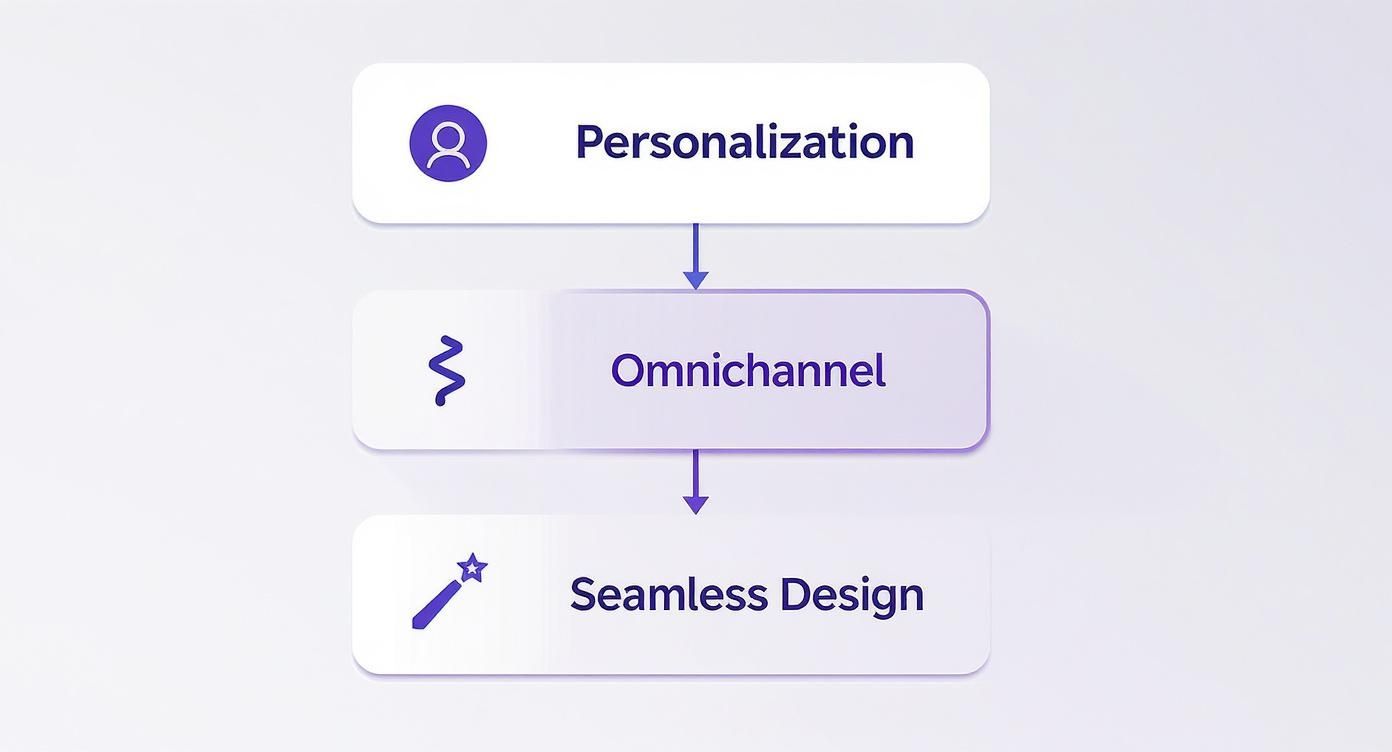
From top to bottom, it emphasizes how Personalization, Omnichannel reach, and Seamless Design are fundamental to truly engaging modern consumers. You can learn more about how to structure these systems in our guide to enterprise content management solutions.
By pairing Sitecore’s composable DXP with SharePoint’s robust content capabilities, you lay a foundation for continuous improvement. This architecture not only makes personalization and consistency achievable but also simplifies governance for your entire digital team. From here, you can layer in advanced analytics and A/B testing to fine-tune every touchpoint, building a world-class DXP that evolves right alongside your customers' expectations.
How to Measure and Optimize Your Digital Experience

Building a great digital consumer experience isn't a "set it and forget it" kind of deal. It's a living, breathing discipline that needs constant attention—specifically, continuous measurement and refinement. The trick is to look past the superficial vanity metrics and dial in on the Key Performance Indicators (KPIs) that actually tell you how healthy your customer journey is.
It’s all about creating a data-driven feedback loop. You measure performance, cook up a hypothesis for how to make things better, test that idea, and then measure again. This transforms your strategy from a static project into a dynamic engine for constant improvement.
Moving Beyond Vanity Metrics
It’s incredibly easy to get distracted by numbers like page views or social media likes. While they might feel good, they don't tell you much about the actual quality of the user experience. Instead, savvy digital teams focus on KPIs that directly reflect what customers are feeling and doing.
These deeper metrics give you a clear window into how people are actually interacting with your brand. They pinpoint the exact moments of friction and the areas where you're knocking it out of the park.
Some of the KPIs that really matter include:
- Customer Effort Score (CES): This measures how much work a customer had to put in to resolve an issue, find what they were looking for, or get a task done. A low score here is a fantastic sign of a smooth experience.
- Task Completion Rate (TCR): Simple, yet powerful. This metric tracks the percentage of users who actually finish a specific goal, whether that’s making a purchase or filling out a contact form.
- Customer Lifetime Value (CLV): CLV forecasts the total revenue you can expect from a single customer over their entire relationship with you. A better digital experience directly pumps up this number by encouraging loyalty and repeat business.
Leveraging Sitecore Analytics for Deeper Insights
This is where a platform like Sitecore really starts to flex its muscles. Sitecore Analytics goes way beyond basic web traffic, capturing fine-grained interaction data across every single touchpoint. It lets you trace user paths, see where they're dropping off, and group audiences together based on their behavior.
By digging into this data, you can pinpoint the exact moments of frustration in the customer journey. For example, you might find that people are ditching their carts at a specific checkout step, or that a key landing page has a terrible bounce rate on mobile devices.
This level of granular insight is the bedrock of smart optimization. It lets you shift from guesswork to data-backed decisions, making sure your efforts are aimed where they’ll make the biggest difference.
Once you’ve found a problem area, it's time to form a hypothesis. Maybe you suspect that simplifying the checkout form will boost completion rates. This is where testing becomes absolutely critical. And to tie it all together, you need to understand how these metrics impact the bigger financial picture. You can learn more in our detailed guide on how to measure ROI for your digital projects.
Validating Ideas with Sitecore Personalize
With a hypothesis ready to go, Sitecore Personalize gives you the tools to test it with rigorous A/B and multivariate testing. You can easily set up experiments to pit different versions of a page, a headline, or a call-to-action against each other.
For instance, you could show 50% of your audience the original checkout form (Version A) and the other 50% the new, streamlined one (Version B). Sitecore Personalize automatically tracks how each version performs, giving you hard data on which one drives more conversions.
This continuous loop—measure with Analytics, form a hypothesis, test with Personalize, and measure again—is the engine that powers a winning digital strategy. It builds a culture of constant improvement, ensuring your digital experience evolves right alongside your customers' expectations. For a deeper look at improving your results, a guide on customer experience optimization can be invaluable. This approach turns optimization from a periodic task into a core business function.
Got Questions About Digital Experience? We've Got Answers.
As you dive deeper into the world of digital consumer experience, it's natural for a few practical questions to pop up. Think of this section as a quick FAQ, clearing up some of the common hurdles and reinforcing the ideas we've covered.
What's the Real Difference Between Multichannel and Omnichannel?
It’s easy to get these two mixed up, but the difference is huge.
Most businesses are already multichannel. They have a website, an app, maybe a social media store. The problem is, these channels usually act like they've never met. They're separate storefronts under the same brand, and a customer's journey on one doesn't connect to the next.
Omnichannel is about weaving those threads together into a single, seamless fabric. Picture this: a customer finds a product on your app during their morning commute and adds it to their cart. Later, they open their laptop at work, and that same cart is waiting for them, ready to go. That’s omnichannel. It’s the kind of fluid, connected journey that people now expect, and it's exactly what platforms like Sitecore are built to deliver.
How Does a Composable DXP Actually Make the Experience Better?
A traditional, monolithic DXP is like buying a pre-packaged toolkit. You get everything from one vendor, whether you need it all or not, and you're stuck with their tools.
A composable DXP, like the kind Sitecore offers, completely flips that script. It’s more like building your own custom toolkit. You get to hand-pick the best-in-class tools for every job—content, commerce, personalization—and plug them together with APIs.
The biggest win here is agility. You can swap in new technologies as they emerge and build a tech stack that perfectly matches what you’re trying to achieve. For the digital consumer experience, this means you're never compromising. You're always using the sharpest tool for the task, leading to more flexible and precisely targeted customer journeys built from specialized parts, not a generic, one-size-fits-all box.
A composable architecture sets you free from vendor lock-in. It lets you build a digital experience that’s not just powerful today, but ready for whatever comes next.
Where Should We Even Start with Personalization?
The thought of personalizing everything can be paralyzing. The secret is to start small and aim for a quick win. Don't try to boil the ocean. Just find one or two spots in the customer journey where a little personalization could make a big difference.
A few great places to start are:
- The Homepage: Greet returning visitors with a different hero banner than first-timers.
- Product Pages: Remind users of their "recently viewed items" to nudge them back toward products they were already interested in.
- Category Pages: Feature certain products based on a visitor's location or what they've looked at before.
With a tool like Sitecore Personalize, you can easily set up simple rules-based tests for these scenarios. Once you have the data showing that even basic tweaks boost engagement or conversions, you’ll have all the proof you need to go bigger with more sophisticated, AI-driven strategies.
Ready to start building a digital consumer experience that truly connects with your audience? Kogifi combines deep expertise in Sitecore and SharePoint with sharp UX design and AI-powered strategies. We help you build a DXP that doesn't just work—it delivers. Explore our DXP solutions and let's get started.

















